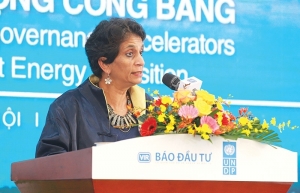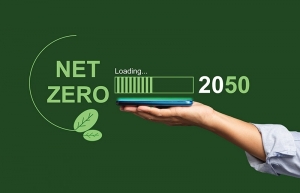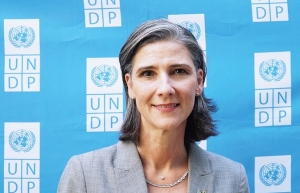Action plans for high-income and low-carbon future
The estimate was revealed in the new Vietnam Country Climate and Development Report (CCDR) produced by the World Bank Group based on one of the first in a series of country-level diagnostics, which lays out a new path to reconcile Vietnam’s growth and climate ambitions.
 |
| Thomas Jacobs-Country manager for Vietnam Cambodia, and Laos International Finance Corporation |
The country has set the goals to become a high-income country by 2045 and achieve net-zero status by 2050. But as the CCDR starkly lays out, it is a country already facing significant climate impacts on its economy and national welfare.
The country has historically had very low greenhouse gas (GHG) emissions, but the past two decades have seen some of the fastest emission growth rates in the world. Vietnam is now one of the most GHG-intensive economies in East Asia.
In a business-as-usual scenario with limited global mitigation efforts, climate change could cost Vietnam up to 14.5 per cent of its GDP annually in roughly 30 years. And without inclusive adaptation responses, climate change impacts have the potential to push a million people into extreme poverty in less than a decade.
To fulfil its future growth ambitions and reduce its vulnerability to climate risks, the CCDR recommends Vietnam shifts its development model by embarking on two distinct pathways – one to build resilience and the other to mitigate climate change by decarbonising growth.
With the right mix of policies and strategies, Vietnam can leverage its decarbonisation efforts to advance development objectives, so that achieving net-zero does not reduce GDP growth. Overall, it is a move that comes with a hefty price tag. Embarking on pathways of adaptation and mitigation will require investments of around $368 billion to 2040, or 6.8 per cent of GDP a year, at the current value. Government resources alone are definitely not enough to meet these financing needs. Mobilising massive amounts of private capital will therefore be pivotal.
The CCDR points out that Vietnam’s private sector is already under pressure. Around $300 billion of assets held by the commercial and industrial sectors are vulnerable to climate-related disasters. Many firms are already reporting climate change impacts that significantly affect their income due to disrupted operations or reduced labour productivity.
A 2020 analysis found climate-related damages, occurring annually, could amount to as much as 70-80 per cent of the total revenue of some small- and medium-sized enterprises. To change that, the private sector will have to make substantial investments of $228 billion through 2050 just to upgrade its assets to adapt to climate change.
 |
| Action plans for high-income and low-carbon future |
A good start could be to reallocate domestic private savings towards climate-related projects. Also, aggressive efforts could help mobilise private financing in the range of 3.4 per cent of GDP annually. The CCDR says this can be achieved by mobilising green credit by banks, developing market-based instruments such as green equities and green bonds, and applying de-risking tools.
Though green finance is in its infancy in Vietnam, the right public policy can help banks overcome bottlenecks through regulatory reforms and incentives for both credit providers and borrowers.
In this context, the government should consider assessing climate-related risks for the financial sector in Vietnam. This can further inform green finance policies. In addition, more targeted actions on climate-related investments in infrastructure, including adjusting the legal public-private partnership (PPP) framework, will be crucial.
Further, a life-cycle asset management approach could be especially useful for Vietnam where a large proportion of the needed finance can be mobilised from the private sector through management contracts or PPPs. Under this system, the government retains control over the assets but transfers the daily operations to the private sector.
Over the medium to long term, reforming state-owned enterprises and opening the market to greater private sector participation in the economy will be essential to achieving much of the climate agenda.
For the private sector, investment opportunities too lay in tackling Vietnam’s main emitting sectors – energy, transport, agriculture, and industry. However, the large financing needs of around $81.3 billion to decarbonise these sectors call for reforms of the investment climate for increased private sector participation and mobilisation of concessional loans. Also, facilitating rapid renewable energy deployment can help with transparency and competitive procurement, further encouraging the private sector.
If Vietnam fully embraces the pathways to boost resilience and decarbonise, its people, the environment, and industries can all benefit. Drawing in greater private sector involvement and greening the economy will help create new jobs and. And it will also help safeguard Vietnam’s competitiveness in global markets.
 | The keys to financing a just energy future Vietnam has made an international commitment to achieve net-zero greenhouse emissions by 2050. Kanni Wignaraja, assistant secretary-general at the UN and regional director for Asia-Pacific at the United Nations Development Programme, writes about how the country can transition to a just energy future, with finance and governance accelerators. |
 | Nation’s net-zero aim given strategic boost Vietnam’s fresh national climate change strategy, which highlights a crucial energy transition, will help the country reduce greenhouse gas emissions and fulfil its international commitment. |
 | Private sector expected to support the green growth model in Vietnam Last year Vietnam made a remarkable commitment to achieve net-zero carbon emissions by 2050. Patrick Lenain, senior associate of the Swiss-based Council on Economic Policies, shares some recommendations to encourage the private sector’s role in this ambitious target. |
 | Ways to fund Vietnam’s COP26 commitments At the 2021 United Nations Climate Change Conference (COP26), Vietnam pledged to reach net-zero carbon emissions by 2050 and to phase out coal-fueled power generation by 2040. |
 | Intensifying climate change a threat to global human rights Vietnam is among the world’s most vulnerable countries to climate change. It is therefore especially encouraging that Prime Minister Pham Minh Chinh committed to net-zero emissions last year. |
What the stars mean:
★ Poor ★ ★ Promising ★★★ Good ★★★★ Very good ★★★★★ Exceptional
Related Contents
Latest News
More News
- Heavy industries set for pilot greenhouse gas quotas (December 25, 2025 | 10:00)
- Swedfund invests in MSME growth and climate action in Vietnam (December 19, 2025 | 11:42)
- GreenYellow brings solar energy to light up remote schools in Tuyen Quang province (December 19, 2025 | 08:00)
- Charge+, Grab partner to develop EV charging network in Vietnam (December 18, 2025 | 17:11)
- Linking sci-tech and innovation to Vietnam’s net-zero future (December 18, 2025 | 14:31)
- Driving double-digit growth through green and circular transformation in Vietnam (December 17, 2025 | 09:00)
- Standard Chartered and ACCA deepen collaboration to develop Vietnam’s talent for a sustainable future (December 15, 2025 | 18:18)
- Schaeffler reports strong early output from Dong Nai solar project (December 12, 2025 | 15:16)
- Forestry conference highlights biodiversity and sustainability goals (December 09, 2025 | 13:35)
- Home Credit honoured among top 10 sustainable companies in trade and services (December 09, 2025 | 12:18)

 Tag:
Tag:



















 Mobile Version
Mobile Version